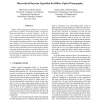Free Online Productivity Tools
i2Speak
i2Symbol
i2OCR
iTex2Img
iWeb2Print
iWeb2Shot
i2Type
iPdf2Split
iPdf2Merge
i2Bopomofo
i2Arabic
i2Style
i2Image
i2PDF
iLatex2Rtf
Sci2ools
AIPR
2005
IEEE
2005
IEEE
Hierarchical Bayesian Algorithm for Diffuse Optical Tomography
Diffuse Optical Tomography (DOT) poses a typical illposed inverse problem with limited number of measurements and inherently low spatial resolution. In this paper, we propose a hierarchical Bayesian approach to improve spatial resolution and quantitative accuracy by using a priori information provided by a secondary high resolution anatomical imaging modality, such as Magnetic Resonance (MR) or X-ray. The proposed hierarchical Bayesian approach allows incorporation of partial a priori knowledge about the noise and unknown optical image models, thereby capturing the function-anatomy correlation effectively. Numerical simulations demonstrate that the proposed method avoids undesirable bias towards anatomical prior information and leads to significantly improved spatial resolution and quantitative accuracy.
Related Content
| Added | 24 Jun 2010 |
| Updated | 24 Jun 2010 |
| Type | Conference |
| Year | 2005 |
| Where | AIPR |
| Authors | Murat Guven, Birsen Yazici, Xavier Intes, Britton Chance |
Comments (0)

